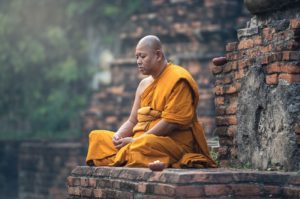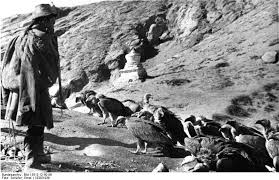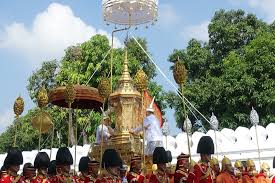Death has a special meaning to Buddhists because it signals the transition from one cycle of existence to another. The solemnity, dignity, and grieving that is characteristic of other religions’ rites are also seen in Buddhist rituals. However, Buddhism often takes on the customs and traditional rituals of the country or region, so observances can vary greatly from place to place.
Varying customs
Buddhist burial rituals frequently take on the character of the country in which the observers live. For instance, in India, Buddhism began as an outshoot of Hinduism and retained many of the rituals of that cultural tradition. Buddhist death practices often incorporate colors, symbols, and practices that are common in the culture. In Tibet, with its rugged landscape, Buddhist burial practices are quite different than in the rigidly organized societies of other lands. In America, a variety of burial practices and funerary rites are seen, due to the range of ethnic backgrounds and Buddhist sects that are found in the country.
Theravadan Buddhism
The divisions within Buddhism itself add even more elements to ritual practices regarding death and burial. Countries that follow Theravadan principles of Buddhism follow the Indian custom of cremating the body as Buddha’s body was handled. Different countries may have a variety of different practices regarding how long the body must be held, washing the body.
 Almost all rituals include chanting by monks, gathering of the community and comforting the family of the deceased. In Theravadan Buddhism, the giving of donations in the name of the deceased helps to add to his merit in the next life. For a period of time after the death, generally 49 days, chanting and prayers are offered to speed the deceased onto his next life. This 49-day period is very important in Buddhism, as the person prepares to take on the karma and elements of his next existence.
Almost all rituals include chanting by monks, gathering of the community and comforting the family of the deceased. In Theravadan Buddhism, the giving of donations in the name of the deceased helps to add to his merit in the next life. For a period of time after the death, generally 49 days, chanting and prayers are offered to speed the deceased onto his next life. This 49-day period is very important in Buddhism, as the person prepares to take on the karma and elements of his next existence.
Mahayana Buddhism
Mahayana Buddhism, with its focus on service to others and returning to serve in future lives, offers much of the same funeral practices of Theravadan Buddhism, such as cremation and chanting, but with a few differences. More emphasis is placed on purifying the karma of the deceased, donations to increase merit and invoking compassion for the living. Mahayana generally invokes different names of the Buddha than Theravadan Buddhism to assist the deceased on his way through the Bardo and into the next life.
Cremation practices
In many of the countries where the Buddhist religion is prevalent, cremation is the culturally accepted method of burial. These countries include India, Vietnam, Japan, China, Cambodia, Laos, Thailand, Malaysia, and Vietnam. As Buddhism spread from India to the surrounding areas, it retained some of the original Hindu traditions, like cremation, while at the same time adding on the ethnic character and customs of its newly adopted land. This integration into the culture caused Buddhism to morph into different forms from country to country. The basic beliefs, such as impermanence and karma, always remained intact, however.
Sky burial
Buddhism came to Tibet centuries ago. It is a land of rugged mountains and extreme temperatures. Earth burial practices were not practical in this type of environment.
 In addition, the traditional, animistic religion of Tibet emphasized ties with nature and the environment. In this society, sky burial was favored, in which the deceased was dismembered and placed on platforms built in the trees so that the vultures could feed on the body. Though this might seem gruesome, it fits with the Tibetan concept of returning to the Earth and all things coming from the Earth. Today in Tibet, however, sky burial is rare due to the Chinese government’s disapproval of this ancient practice.
In addition, the traditional, animistic religion of Tibet emphasized ties with nature and the environment. In this society, sky burial was favored, in which the deceased was dismembered and placed on platforms built in the trees so that the vultures could feed on the body. Though this might seem gruesome, it fits with the Tibetan concept of returning to the Earth and all things coming from the Earth. Today in Tibet, however, sky burial is rare due to the Chinese government’s disapproval of this ancient practice.
Embalming and ground burial
In westernized countries, Buddhists often employ embalming and ground burial that is the accepted practice in the culture, while incorporating the reading of sutras, chanting by Buddhist monks and observation of the 49-day Bardo period of prayer after death. Ethnicity can often add a variety of other practices, some of which are individual to the family of the deceased.





